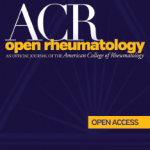Priming the Pump
By most accounts, the journal really began to take off in 2001 after the CJP made the decision, in 2000, to merge the two journals. Publishing AC&R bimonthly as a section of A&R led to PubMed indexing. “That was the tipping point,” says Dr. Alarcón.
Although the move was positive, it contained some controversy. For A&R, the move was a calculated risk, since including the sister journal under its wing could have an effect on its impact factor. David S. Pisetsky, MD, PhD, professor of medicine and immunology at the Duke University Medical Center in Durham, N.C., and chief of rheumatology at the Durham VA Medical Center, who was editor of A&R from 2000–2005, says, “I think everybody knew that when we combined the journals, the impact factor of A&R would go down somewhat. We thought, on balance, that that was a wise decision—and I still agree—and that it would not affect the standing of A&R.”
In addition, say Drs. Alarcón and Callahan, ARHP members were concerned that the shift to a more clinical focus meant rheumatology health professionals would not have a journal solely dedicated to their domain. But indeed, says Dr. Callahan, the compromise allowed the journal to survive. “Overall, rheumatologists and professionals working in the field have gained” from the changes, agrees Dr. Alarcón.
Gene G. Hunder, MD, professor emeritus in the department of internal medicine/rheumatology at the Mayo Clinic, Rochester, Minn., steered AC&R through the first years of the merged publications. “My charge was to secure more clinically related articles that were starting to go to other journals,” he recalls. “I thought it was an interesting challenge.” It was a growth period, and Dr. Hunder did a fair amount of soliciting submissions from presenters at ACR meetings. “By the time I finished [he served as editor from 2000–2005] we had quite a few more articles submitted, and our rejection rate had increased from an original 20% to around 60%,” a reflection of the increasing quality of submissions. Dr. Hunder also initiated “Pro and Con,” “Updates,” and “Trainee Rounds,” three new article types to stimulate readership. “It was a lot of fun,” he says. “And I think we saved it from being deleted as a journal. Now it has established itself very nicely.”
The Turnaround Phase

Leslie Crofford, MD, professor of medicine at Vanderbilt University in Nashville, Tenn., chaired the CJP from 2003–2005. As Dr. Hunder’s term as editor drew to a close, the committee was charged with appointing his successor. “We wanted to find the right editors for the journal,” recalls Dr. Crofford. “At the end of the day, we felt that the research credentials that Drs. Katz and Yelin brought to the journal, with a focus on outcomes, epidemiology, and health services research, meant that they would be the right editors for that period of time.”


